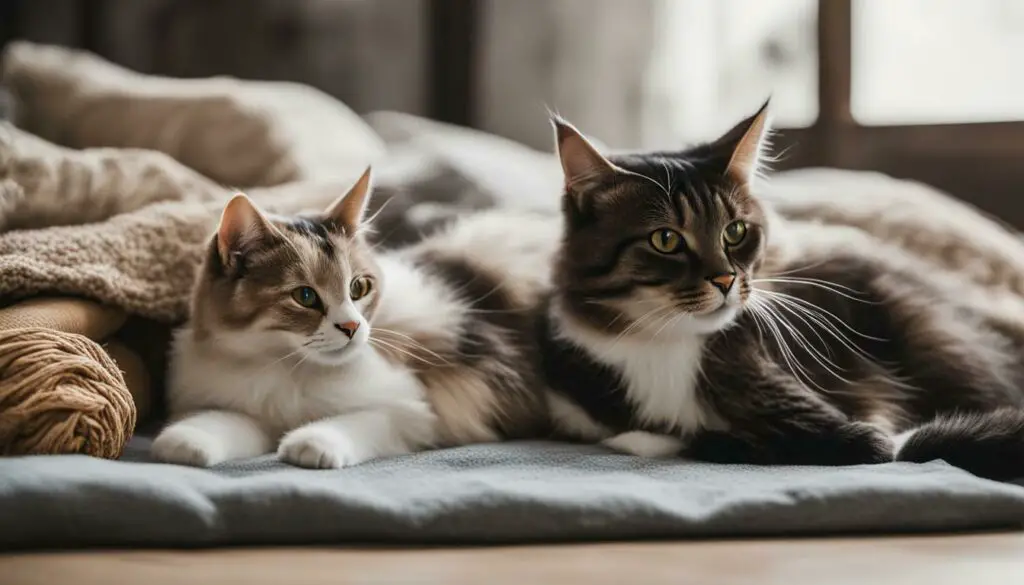Are you struggling with cats fighting in your home? Discover effective strategies to prevent cat aggression and create a peaceful atmosphere for your feline friends.
To stop cats from fighting and create a peaceful household, there are several tips to consider. First, identify the causes of conflict, such as mealtimes, playtimes, or a lack of individual space. Provide enough hiding, climbing, sleeping, and perching spaces for each cat to avoid territorial disputes. Ensure there are enough resources like food and water bowls, scratching posts, and litter boxes for each cat, with an extra one available. Be careful with rewarding and giving attention to cats, as this can help redirect aggressive behavior. Consider rewinding and controlling introductions if the fighting has been going on for a while, starting with separate spaces and gradually reintroducing the cats. If necessary, consult a vet to rule out any underlying medical issues. Additionally, FELIWAY Optimum Diffuser can help reduce conflict between cats. If aggression persists, seek help from a certified behaviorist or veterinarian.
Key Takeaways:
- Identify the causes of conflict and address them accordingly.
- Provide enough individual spaces and resources for each cat.
- Be mindful of rewarding and giving attention to cats.
- Consider rewinding and controlling introductions if fights persist.
- Consult a veterinarian to rule out medical issues.
Understanding the Causes of Cat Fights
Cat fights can often stem from underlying factors like territorial behavior and resource guarding. Understanding these causes is the first step towards resolving conflicts between your cats. In many cases, cats fight over access to certain areas of your home, such as feeding areas, sleeping spots, or litter boxes. They might feel threatened by the presence of another cat in their territory and react aggressively to protect what they perceive as theirs.
Resource guarding, where cats become possessive over their food, toys, or favorite spots, can also lead to fights. Cats may feel threatened when another cat approaches their possessions, resulting in aggressive behavior. Identifying these triggers can help you address the root causes of the conflict and implement appropriate solutions.
Creating a peaceful environment for your cats starts with providing enough individual spaces and resources for each cat. This includes offering hiding spots, perches, and comfortable sleeping areas where they can retreat to when they need some alone time. Additionally, make sure there are multiple food and water bowls, litter boxes, and scratching posts available to avoid competition and reduce the likelihood of fights breaking out.
| Causes of Cat Fights | Prevention Strategies |
|---|---|
| Territorial disputes | Provide individual spaces and resources |
| Resource guarding | Ensure sufficient food, water, and litter box availability |
| Competition for attention | Manage attention and rewards given to each cat |
| Uncontrolled introductions | Rewind and control introductions gradually |
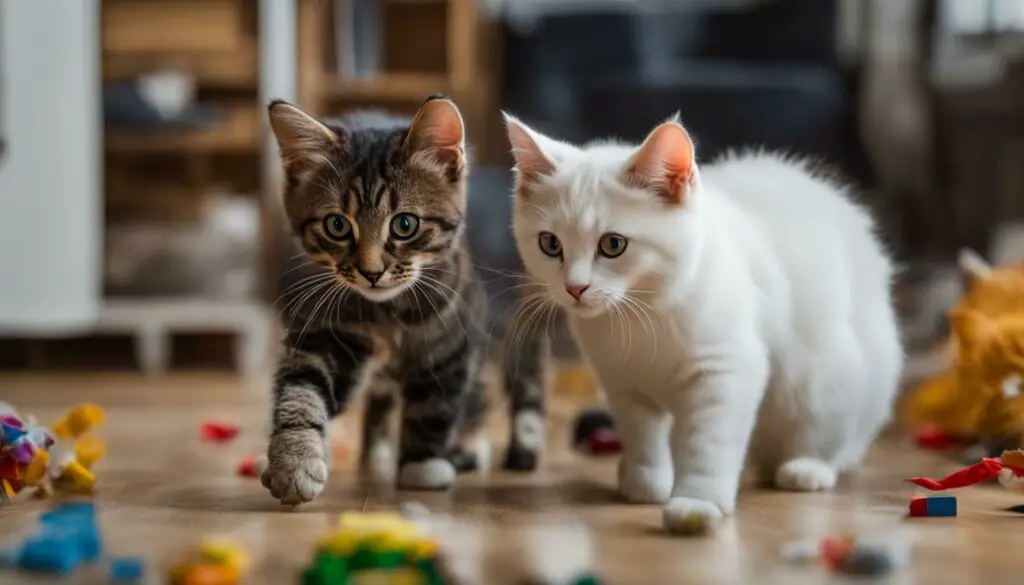
Tips to Prevent Cat Fights:
- Regularly clean and maintain litter boxes to reduce stress and eliminate potential triggers for conflict.
- Establish a consistent feeding routine and ensure each cat has its own designated eating area.
- Provide interactive toys and engage in play sessions to redirect their energy and prevent frustration.
- Consider using FELIWAY Optimum Diffuser, a natural pheromone-based product, to create a calming environment for your cats.
Understanding the underlying causes of cat fights is key to finding effective solutions. By creating a harmonious living space with ample resources and addressing territorial behaviors, you can minimize conflicts and promote a peaceful coexistence among your feline friends.” – Certified Feline Behaviorist
If the aggressive behavior persists despite your efforts, it is advisable to consult a veterinarian or certified behaviorist. They can provide further guidance, assess the situation more closely, and recommend additional strategies to help your cats live harmoniously.
Remember, a little extra attention and understanding can go a long way in creating a peaceful household where your beloved cats can thrive and coexist happily.
Providing Individual Spaces and Resources
Ensuring each cat has their own designated spaces and resources is essential for promoting a harmonious living environment and preventing cat fights. Cats are territorial animals, and conflicts often arise when they feel their personal boundaries are being encroached upon. To minimize tension and aggression, it is crucial to provide enough individual spaces that allow each cat to have their own retreat.
“Cats are territorial animals, and conflicts often arise when they feel their personal boundaries are being encroached upon.”
Creating a multi-level environment with ample hiding spots, climbing platforms, and perching areas can help cats establish their own territories and reduce the chances of confrontations. Consider adding cat towers, wall shelves, or window perches to provide vertical spaces for each cat to claim and explore. These elevated areas not only serve as observation points but also allow cats to escape from potential conflicts.
“Creating a multi-level environment with ample hiding spots, climbing platforms, and perching areas can help cats establish their own territories and reduce the chances of confrontations.”
Additionally, ensure there are enough resources available to prevent competition or resource guarding. Each cat should have their own food and water bowls, scratching posts, and litter boxes. It is recommended to have an extra set of resources to avoid conflicts when cats prefer certain spots or have differing preferences.
Table: Recommended Number of Resources
| Resources | Number of Cats | Number of Resources |
|---|---|---|
| Food and Water Bowls | 1-2 cats | 2 sets |
| Scratching Posts | 1-2 cats | 2 posts |
| Litter Boxes | 1-2 cats | 2 boxes |
By providing individual spaces and resources, you can minimize stress and territorial conflicts between your cats, creating a peaceful coexistence in your household. Remember to observe their behavior and make adjustments accordingly to ensure each cat feels safe and secure within their environment.
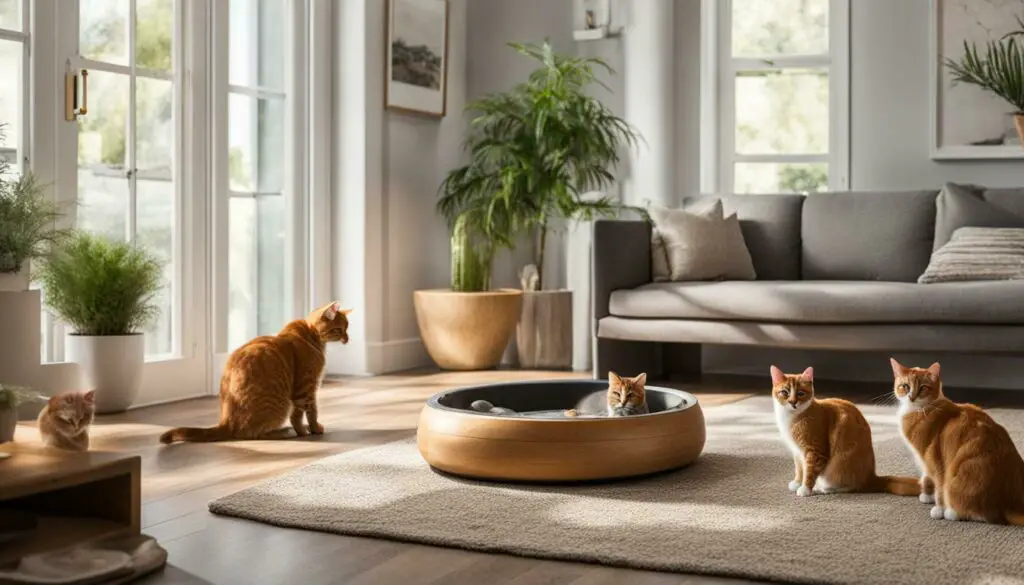
Reducing Attention-Based Aggression
It’s important to be mindful of how you reward and interact with your cats to prevent attention-based aggression and redirect their behavior towards positive outlets. Cats are intelligent and sensitive creatures, and they crave attention and stimulation. However, if they don’t receive it in a constructive way, they may resort to aggressive behavior to get your attention.
When your cats are displaying aggressive behavior, avoid yelling or punishing them. This can escalate the situation and make them feel more anxious or threatened. Instead, focus on redirecting their behavior. Provide interactive toys, scratching posts, and puzzle feeders to engage their minds and provide outlets for their energy. This will not only reduce their aggression but also keep them mentally stimulated and physically active.
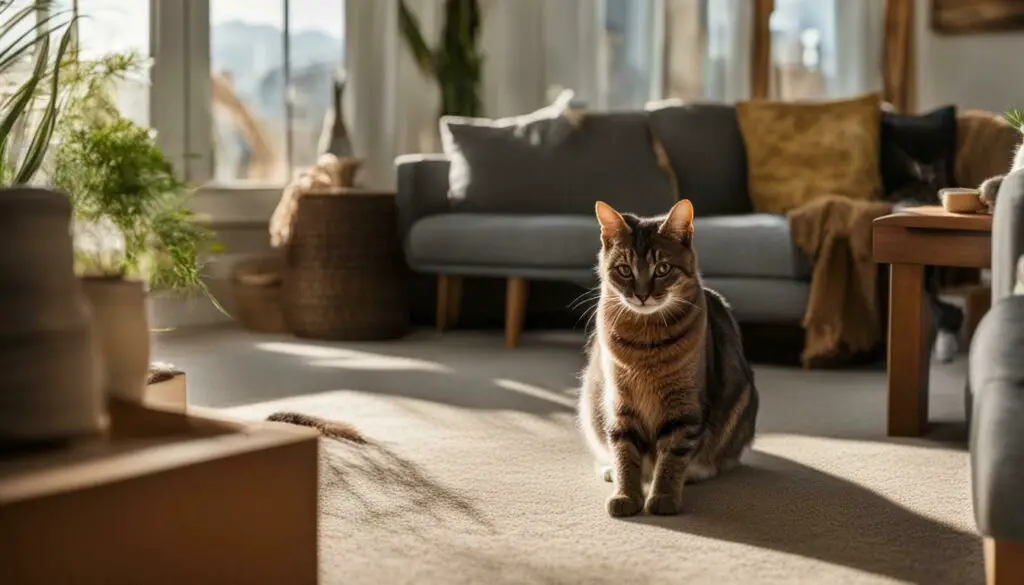
Creating a calm and positive environment is also crucial in reducing attention-based aggression. Ensure that your cats have their own space and time for relaxation. Provide cozy beds, comfortable hiding spots, and perches for them to observe their surroundings. Additionally, establish a routine that includes regular playtimes, feeding times, and quiet times. This will help them feel secure and lessen their need to compete for resources or attention.
Remember, cats thrive on consistency and positive reinforcement. Reward them with treats, praise, and affection when they display desired behaviors, such as playing nicely together or using their scratching post. This will reinforce positive associations and encourage them to continue engaging in appropriate behaviors.
| Key Tips to Prevent Attention-Based Aggression: |
|---|
| Provide interactive toys, scratching posts, and puzzle feeders to redirect their energy. |
| Ensure each cat has their own space for relaxation, with cozy beds, hiding spots, and perches. |
| Establish a consistent routine that includes regular playtimes, feeding times, and quiet times. |
| Reward desired behaviors with treats, praise, and affection to reinforce positive associations. |
By implementing these strategies and being mindful of your cats’ needs, you can effectively reduce attention-based aggression and create a peaceful and harmonious environment for your feline companions.
Rewinding and Controlling Introductions
If cat fights have been persistent, consider rewinding and controlling introductions to establish a more positive relationship between your feline companions. This process involves creating separate spaces for each cat and gradually reintroducing them in a controlled manner.
Start by providing each cat with their own designated area, complete with food, water, litter boxes, and a comfortable place to rest. This will allow them to feel secure and minimize any potential territorial disputes.
After a period of separation, you can slowly introduce the cats to each other in a supervised environment. Use a baby gate or a screen door to create a physical barrier that allows them to see and smell each other without direct contact. This visual and olfactory exposure will help them become familiar with each other’s presence.
Over time, you can gradually increase their interaction by allowing short, supervised visits. This can be done by opening the gate or door for brief periods, gradually extending the duration as long as both cats remain calm and non-aggressive. Reward positive interactions with praise and treats to reinforce good behavior.

Remember, patience is key during this process. Each cat will progress at their own pace, and it’s important to respect their individual comfort levels. If any signs of aggression or tension arise, separate the cats and try again later. It may take time, but with consistent effort and positive reinforcement, you can help your cats develop a harmonious relationship.
| Key Tips for Rewinding and Controlling Introductions: |
|---|
| 1. Create separate spaces for each cat with essential resources. |
| 2. Use a baby gate or screen door to allow visual and olfactory exposure. |
| 3. Gradually increase supervised visits, rewarding positive interactions. |
| 4. Be patient and respect each cat’s individual comfort levels. |
Consulting a Veterinarian
If cat fights persist despite your best efforts, seeking professional advice from a veterinarian can help identify any underlying health issues that may be causing or exacerbating the conflicts. Cats are known to hide signs of illness or discomfort, and these underlying conditions can contribute to aggression or territorial behavior.
A veterinarian will be able to conduct a thorough examination of your cats to rule out any medical problems that could be influencing their behavior. They may recommend blood tests, urinalysis, or other diagnostic procedures to uncover any potential health issues. Additionally, they can provide guidance on managing and reducing aggression, including behavioral modification techniques or the use of medication if necessary.
Remember, aggression in cats can be complex, and it’s important to approach any potential health concerns with the help of a professional. With the assistance of a veterinarian, you can create a personalized plan to address the underlying causes of the conflicts, helping your cats live harmoniously in your home.
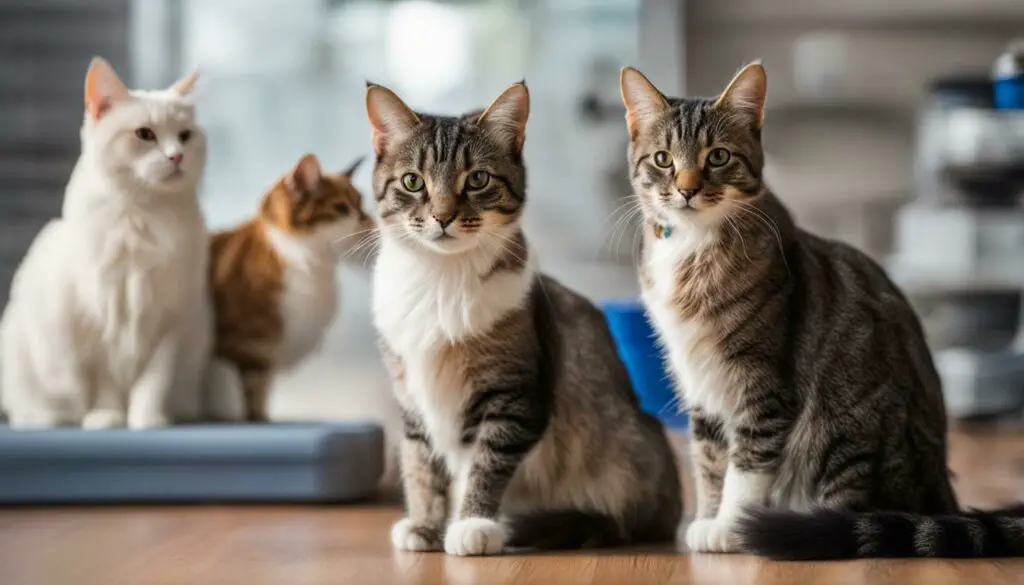
| Signs of Underlying Health Issues in Cats: |
|---|
| 1. Changes in appetite or weight |
| 2. Changes in litter box habits |
| 3. Lethargy or decreased activity level |
| 4. Excessive grooming or hair loss |
| 5. Respiratory issues, such as coughing or sneezing |
| 6. Vomiting or diarrhea |
- Seek professional advice from a veterinarian if cat fights persist.
- Veterinarians can conduct thorough examinations to identify underlying health issues.
- Diagnostic tests like blood work may be recommended.
- Veterinarians can provide guidance on managing aggression and suggest behavioral modification techniques.
- Look out for signs of underlying health issues in your cats.
“A veterinarian’s expertise can help ensure the well-being and harmony of your feline companions.”
Using FELIWAY Optimum Diffuser
Consider using FELIWAY Optimum Diffuser, a clinically proven product, to help minimize cat aggression and promote a more harmonious atmosphere in your home. This diffuser releases a synthetic copy of the feline facial pheromone, which helps create a calming environment for cats. The pheromone is a natural indicator of comfort and reassurance for cats, helping to reduce stress and tension.
By incorporating FELIWAY Optimum Diffuser into your cat’s environment, you can help create a sense of security and reduce the likelihood of aggressive behavior. Simply plug in the diffuser in an area where your cats spend the most time, and the pheromone will spread throughout the room, providing a continuous calming effect. This can be especially beneficial during stressful situations, such as introducing new cats or changes in the household.
The use of FELIWAY Optimum Diffuser can complement other behavioral strategies mentioned earlier, such as providing individual spaces and resources, managing attention-based aggression, and controlling introductions. It is a non-invasive and drug-free solution that can be used alongside other measures to enhance the overall well-being of your cats.
To ensure the best results, it is recommended to use the FELIWAY Optimum Diffuser continuously for at least 30 days. This will allow your cats to fully benefit from the calming effects of the pheromone and help establish a peaceful coexistence between them. Remember, each cat is unique, and it may take some time to see noticeable improvements. Patience and consistency are key in creating a harmonious environment for your feline friends.
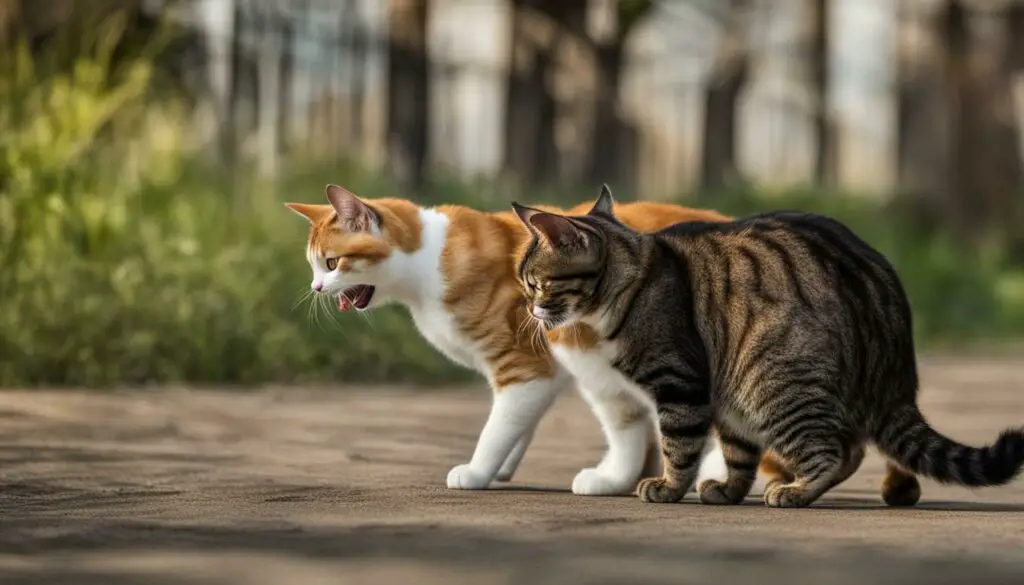
| Key Benefits of FELIWAY Optimum Diffuser |
|---|
| Reduces cat aggression and fights |
| Promotes a relaxed and calm environment |
| Helps cats feel secure and comfortable |
| Non-invasive and drug-free solution |
| Safe for cats of all ages and breeds |
Seeking Help from a Behaviorist or Veterinarian
If all else fails, don’t hesitate to reach out to a certified behaviorist or veterinarian who specializes in cat behavior for expert guidance on resolving cat conflicts. These professionals have the knowledge and experience to assess the situation and provide tailored solutions to help restore peace in your home.
A behaviorist or veterinarian will conduct a thorough evaluation of your cats’ behavior, taking into account their history, living environment, and any medical conditions that may be contributing to their aggression. They can offer valuable insights and strategies to address the underlying causes of the fights and implement effective behavior modification techniques.
In addition to providing guidance on managing cat conflicts, a behaviorist or veterinarian can also assist in developing a comprehensive management plan that includes environmental enrichment, training exercises, and appropriate socialization techniques. They will work closely with you to ensure that the plan is tailored to your specific situation and supports the well-being of your cats.
Remember, seeking professional help is not a sign of failure but rather a proactive step towards creating a harmonious living environment for your feline companions. With the expertise of a behaviorist or veterinarian, you can navigate the complexities of cat aggression and find a solution that benefits both you and your beloved pets.

| Benefits of Seeking Professional Help for Cat Conflicts |
|---|
| Expert evaluation and assessment of cat behavior |
| Personalized behavior modification strategies |
| Comprehensive management plan for your home |
| Support in creating a harmonious living environment |
Conclusion
By implementing these techniques and understanding the underlying causes of cat fights, you can create a harmonious and happy living environment for your feline companions.
To stop cats from fighting and resolve conflicts, it’s essential to identify the root causes of aggression. Is it triggered by mealtimes, playtimes, or a lack of individual space? Providing enough hiding spots, climbing surfaces, sleeping areas, and perching spots for each cat can prevent territorial disputes and promote peaceful coexistence.
Additionally, ensuring an adequate number of resources like food and water bowls, scratching posts, and litter boxes is crucial. Each cat should have their own set of resources, with an extra one available to avoid competition and potential conflicts. Rewarding and giving attention to cats should be done carefully to redirect aggressive behavior and discourage fighting.
If cat fights persist, consider rewinding and controlling introductions. Separate the cats into different spaces and gradually reintroduce them, allowing them to get acquainted and adjust to each other’s presence. If needed, consult a veterinarian to rule out any underlying medical issues that may be contributing to the aggression.
As an additional tool, the FELIWAY Optimum Diffuser can help reduce conflict between cats by releasing calming pheromones that create a more relaxed atmosphere. This can be especially beneficial in multi-cat households where tension is high.
If the aggression continues despite your efforts, it’s important to seek help from a certified behaviorist or veterinarian. They can assess the situation, provide expert advice, and develop a customized plan to address the specific needs of your cats.
By following these techniques and seeking professional assistance when necessary, you can create a safe and peaceful environment where your cats can thrive and coexist peacefully.
FAQ
What are the common causes of cat fights?
Common causes of cat fights include territorial disputes, resource guarding, and social hierarchy issues.
How can I provide individual spaces for my cats?
To provide individual spaces, ensure there are enough hiding spots, climbing structures, sleeping areas, and perches for each cat.
What resources should I provide for each cat?
Each cat should have their own food and water bowls, scratching posts, litter boxes, and toys. It’s also a good idea to have an extra litter box available.
How can I reduce attention-based aggression?
Be mindful of rewarding and giving attention to aggressive behavior. Instead, redirect their attention to more positive activities or toys.
How do I control introductions between cats?
Start by keeping the cats in separate spaces and gradually reintroduce them under controlled circumstances, allowing them to get used to each other’s presence.
When should I consult a veterinarian?
If cat fights persist or escalate, it’s important to consult a veterinarian to rule out any underlying medical issues and obtain professional guidance.
How can FELIWAY Optimum Diffuser help reduce cat conflicts?
FELIWAY Optimum Diffuser releases pheromones that help create a calm environment and reduce tension between cats.
What should I do if the aggression persists?
If cat fights continue despite implementing the tips mentioned, it’s recommended to seek help from a certified behaviorist or veterinarian who specializes in cat behavior.

